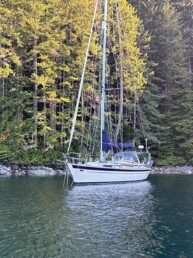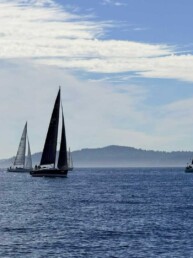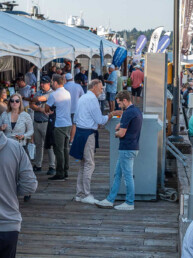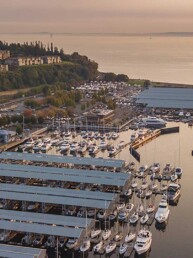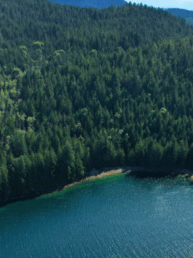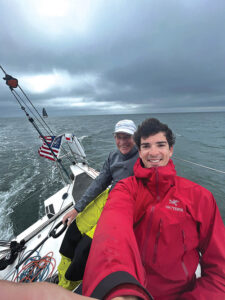
The idea of doing the Spi Ouest Regatta in La Trinité sur-Mer dawned on me and my co-skipper, Jonathan Mckee, while we were wrapping up up our adventure at the Rolex Middle Sea Race last fall. We had a successful race in many ways, but as Pacific Northwest sailors racing in unfamiliar waters on a boat that was relatively new to us — there were times we didn’t know how to sail it best in the varying conditions. We made good decisions, but we had a lot of work to do on our speed and boat handling.
Spi Ouest was the perfect place to hone these skills. It is a four-day regatta where boats in the IRC Doublehanded fleet sail one 15-40 mile race each day. The courses are random legs, with a variety of wind angles and directions, and the Bay of Quiberon is a complex race area full of rocky coastlines, strong currents, and plenty of navigational hazards typical of the Breton coast. We had our work cut out for us to be competitive in the very tough 58-boat French IRC Doublehanded fleet.
Jonathan and I arrived in France four days before the regatta began and enjoyed a few great days of training and boat preparation, as well as a field trip up to Lorient to enjoy the spectacle that is La Base (home-base for most of the French Imoca 60 and Ultim teams).
Day one of racing brought us a 7-10 knot easterly and we set off upwind on a 10 mile beat. We rounded somewhere in the top-half of the fleet after some navigational challenges on the first leg. After that, we showed good pace and made some solid calls on the downwind. We crossed the line fourth and corrected to fourth as well. However! That fourth quickly turned into a 58 as we learned that we had been OCS in the first race of what would be a no-drop series. After our disappointment faded, we committed ourselves to finishing the regatta as well as we possibly could.
Race day two sent the fleet on a 36-mile course around the Ile de Houat. Similar to the first day, we struggled to get off the line cleanly. However, once we got around the weather mark and on to the masthead Code Zero across the Bay of Quiberon, we quickly pulled ourselves into the top 10. Once the angle began to free up, we peeled to the A2 and continued to run down the leaders in our class. In spite of this progress, we struggled once again as we turned upwind for the 9-mile beat up the outside of the Island. Distracted by our lack of upwind performance, we made a few tactical errors and found ourselves back in the thick of the pack, battling it out as we short-tacked the rocky shore.
Now, while we PNWers think we know what it takes to short-tack a shore in foul current, the French take it to another level of commitment and desire. We quickly realized that in order to be competitive we would have to push our limits of boat positioning in order to compete with the top boats. In the end, we found a good balance between safety and performance and rounded the top of the island in the top quarter. Down the run, we elected to take a couple of jibes toward shore to stay in better pressure and this ended up paying dividends. We ended up finishing third over the line as well as third on corrected time.
The course on race day three sent us on a slightly shorter 26-mile track around the Bay of Quiberon. Jonathan executed a great start and had the boat moving quickly on the first beat in 13-15 knots. We rounded the weather mark just behind the lead SF3600 and quickly set the A2 for the kite reach down to Phare de la Teignouse.
After rounding in third, we were confronted with 2-2.5 knots of crosscurrent taking us out of the bay. We elected to continue straight and hoped to find some relief on the opposite shore. However, in the end, boats that did a few tacks to get farther inside seemed to escape the worst of the current and made gains. We rounded another small island in the southern part of the bay and then began a series of spinnaker reaches back and forth across the bay where we managed to pick off a few boats. After a short final beat and run we managed to cross the line fifth, correcting to fourth.
The final day of racing had a slightly different flavor. An approaching front was forecast to bring an 18-25 knot westerly and plenty of rain to go along with it. We were finally experiencing the Brittany we had come prepared for! We battled it out at the pin but ended up having to tack out and take quite a few sterns early on in the race. Fortunately, Jonathan had the boat dialed in and once I found us a decent lane on port, we drag-raced to the starboard lay line and managed to round in the top 10.
Next up was a fast kite reach in 18-20 knots at around 135-degree true wind angle. On this leg, we managed to pass 4-5 boats in conditions the scow-bow SF3300 relishes! We then had a 5-mile beat up to the Phare de la Teignouse where it was all to play for with a full-on match race versus the JPK 10.30 Léon (the DH winners of the 2021 Fastnet) with Jean-Pierre Kelbert (Mr. JPK himself) and Figaro legend Frederic Duthil onboard. We were able to eek ahead of the French pairing and rounded the next mark having extended from the rest of our fleet. The wind was now consistently over 20 knots and we had a screaming jib reach to the final mark where we set the kite for the run back to the finish. We managed to keep things relatively tidy and continued to extend from our competitors. We finished third over the line and corrected to third in what felt like maybe our most complete performance so far.
Our final scoreline was OCS, 3,4,3 which yielded us 14th overall in a fleet of 58. However, the scoreline alone doesn’t capture the pleasure we experienced, and the knowledge and experience we gained from racing against the extremely competitive French IRC DH fleet. We look forward to returning to La Trinité in July for the first race of the RORC IRC Doublehanded Europeans and lining up with some of these incredible competitors again.

